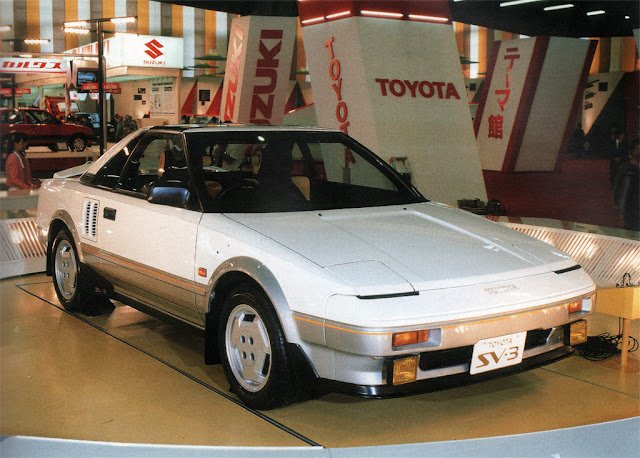At its introduction in 1984, it won the Car of the Year Japan Award. The Toyota MR2 is a two-seat (2), mid-engined (M), rear-wheel-drive (R) sports car produced by Toyota, from 1984 until July 2007 when production stopped in Japan. In France the name was shortened to MR. There are three different generations of the MR2:
Generation 1 (W10): 1984–1989
Generation 2 (W20): 1989–1999
Generation 3: (W30): 1999–2007
It was designed to be small, with an economical powerplant, but sporty in style and handling. Basic design elements, such as MacPherson strut front and rear suspensions and transverse-mounted inline-four engines, are common to all three generations of MR2, though each generation differs greatly from the next in particulars.
The actual design work began in 1979. The choice was made to place the engine transversely in the middle of the car. From its base design, the car began evolving into an actual sports car. Toyota made its SV-3 concept car (photo below) public in October 1983 at the Tokyo Motor Show, gathering a huge amount of publicity both from the press and the audience. The car was to become the first mass-produced mid-engined car to come from a Japanese manufacturer. (wikipedia)
Generation 1 (W10): 1984–1989
Generation 2 (W20): 1989–1999
Generation 3: (W30): 1999–2007
It was designed to be small, with an economical powerplant, but sporty in style and handling. Basic design elements, such as MacPherson strut front and rear suspensions and transverse-mounted inline-four engines, are common to all three generations of MR2, though each generation differs greatly from the next in particulars.
The actual design work began in 1979. The choice was made to place the engine transversely in the middle of the car. From its base design, the car began evolving into an actual sports car. Toyota made its SV-3 concept car (photo below) public in October 1983 at the Tokyo Motor Show, gathering a huge amount of publicity both from the press and the audience. The car was to become the first mass-produced mid-engined car to come from a Japanese manufacturer. (wikipedia)
Toyota MR2 - Generation 1 (1984-89)
The folded angular lines evoked origami paper sculpture. Other cars with a similar design concept including the Lancia Beta Montecarlo, Fiat X 1/9 and the exotic Lancia Stratos were all produced in the 70s and early 80s. The most important features of the MR2 were its light body, superior handling and lightly powered, small-displacement engine.
Toyota chose to use the naturally aspirated 4A-GE 1,587 cc inline-four engine, a dual overhead-cam, four-valve-per-cylinder motor, borrowed from the E80 series Corolla. This engine was also equipped with DENSO electronic port fuel injection and a variable intake geometry ("T-VIS"), giving the engine a maximum power output of 112 hp (84 kW) in the US, 128 hp (95 kW) in the UK, 116 or 124 PS (85 or 91 kW; 114 or 122 hp) in Europe (with or without catalytic converter), 118 hp (88 kW) in Australia and 130 PS (96 kW; 128 hp) in Japan. Japanese models were later downrated to 120 PS (88 kW; 118 hp). The car is often identified as the AW11, referring to the chassis code of the most common 1.6-litre, A-engined versions.
In 1987, Toyota introduced a supercharged engine for the MR2. Based on the same block and head, the 4A-GZE was equipped with a small Roots-type supercharger and a Denso intercooler. T-VIS was eliminated and the compression ratio was lowered to 8:1. It produced 145 hp (108 kW) and 140 pound-feet (190 N·m) and accelerated the small car, the MR2 SC, from 0 to 100 km/h (0 to 62 mph) in 6.5 to 7.0s. (wikipedia)
1986 Toyota 222D Group S Rally Car
In 1985 Toyota Team Europe started a rally project codenamed "222D" based on the Gen. 1 MR2, for competition in Group S and potentially Group B rally racing. Though somewhat similar on the outside, it's clear that it shared very little with the production car. Little is known about this project because it never competed.
The rules for Group S were to stipulate that competing cars be limited to 300hp, and that only 10 units needed to be built for homogolation, as opposed to the 200 units for Group B. However, a series of major accidents in 1986, some of them fatal, resulted in the cancellation of the Group B Rally. The tragedies also brought about the scrapping of Group B's proposed replacement: Group S. As a result, only a handful of 222D prototypes and three MR2 Group S rally vehicles were built.
These were not true Group S cars however, as the Group S rules limited engine capacity to 1.2L. Instead they were hybrid Group B/ Group S cars. All three motors were turbocharged, and had a displacement of 2.0 L. While not known for sure, the engine could have been the either 4T-GTE as used in the celica rally car preceding it, or it possibly could have been the famous 503E used in the GTP cars. Boasting a 600-hp powerplant, one was designed for tarmac rallies, while the other two were suited to gravel rallies. (wikipedia, wikicars.org motorsportretro.com & autoguide.com)
1983 Toyota SV-3 Concept
(Photos from petrolicious.com, autowp.ru, speedhunters.com,
kijiji.ca, carstyling.ru & commons.wikimedia.org)































































